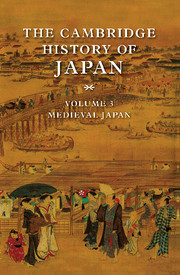Book contents
- Frontmatter
- Introduction
- 1 The Kamakura bakufu
- 2 Medieval shōen
- 3 The decline of the Kamakura bakufu
- 4 The Muromachi bakufu
- 5 Muromachi local government: shugo and kokujin
- 6 The decline of the shōen system
- 7 The medieval peasant
- 8 The growth of commerce in medieval Japan
- 9 Japan and East Asia
- 10 CULTURAL LIFE IN MEDIEVAL JAPAN
- 11 The other side of culture in medieval Japan
- 12 Buddhism in the Kamakura period
- 13 Zen and the gozan
- Works cited
- Glossary
- Index
- References
5 - Muromachi local government: shugo and kokujin
Published online by Cambridge University Press: 28 March 2008
- Frontmatter
- Introduction
- 1 The Kamakura bakufu
- 2 Medieval shōen
- 3 The decline of the Kamakura bakufu
- 4 The Muromachi bakufu
- 5 Muromachi local government: shugo and kokujin
- 6 The decline of the shōen system
- 7 The medieval peasant
- 8 The growth of commerce in medieval Japan
- 9 Japan and East Asia
- 10 CULTURAL LIFE IN MEDIEVAL JAPAN
- 11 The other side of culture in medieval Japan
- 12 Buddhism in the Kamakura period
- 13 Zen and the gozan
- Works cited
- Glossary
- Index
- References
Summary
INTRODUCTION
In contrast with that of the Kamakura bakufu, the authority of the Muromachi bakufu expanded rapidly following its establishment in 1336, and the Ashikaga shogun became almost an absolute monarch. In the provinces, shugo (military governors) were installed in sixty-six administrative units, or provinces. In Kyushu and in the area from the Kantō eastward, shogunal authority was delegated to regional bakufu headquarters with administrative control over large areas, called the Kantō kubō and the Kyushu tandai. An intermediate area encompassing the Kinai, or central provinces, was under direct shogunal rule. The authority of the shugo, in addition to their three major duties inherited from the Kamakura period – punishing murderers, putting down rebellions, and providing men for guard duty – was enhanced by the addition of jurisdiction over land-related matters. Besides holding nearly all military and administrative authority over the provinces, the shugo organized local overlords, called kokujin, into retainer bands. This process, called vassalization, progressed as the shugo gradually suppressed kokujin resistance. In an attempt to contain the increasing power of the shugo, the bakufu used control measures such as appointing members of the shugo's collateral family to the shogun's army to serve as captains of the shogun's bodyguard, but from the time of the Onin War (1467–77), the shugo's increasing separation and independence from the bakufu became undeniable, and the decentralization of local authority proceeded apace. Most of the sengoku daimyo, great sixteenth-century local warriors who controlled their own territories, could trace their lineages back to the Muromachi shugo or to their retainers, the deputy shugo (shugodai).
- Type
- Chapter
- Information
- The Cambridge History of Japan , pp. 231 - 259Publisher: Cambridge University PressPrint publication year: 1990
References
- 1
- Cited by

